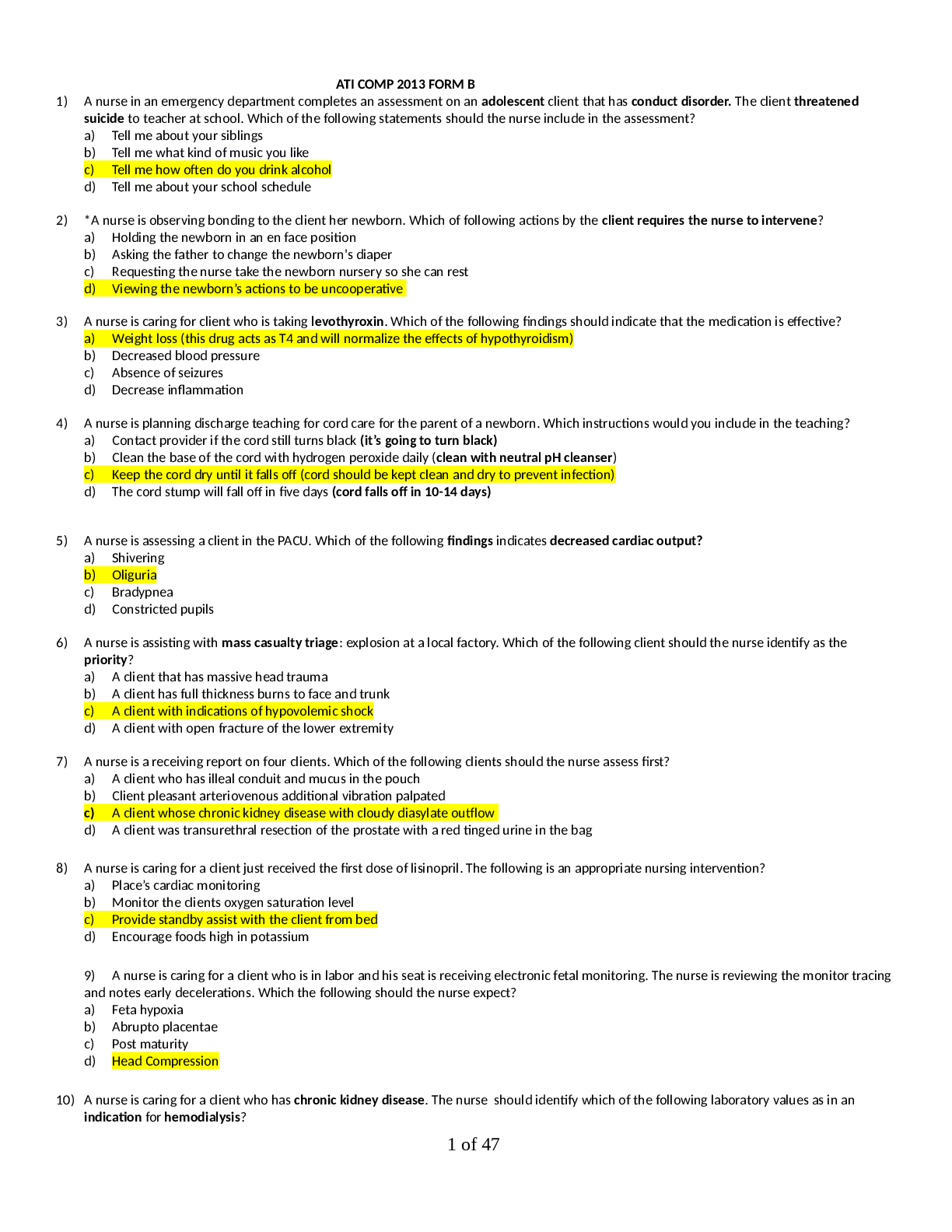*NURSING > STUDY GUIDE > NR 442 Community Health Nursing Exam 1 /Test Matrix Exam 1 (Chapters: 1, 2, 5, 6, 7, & 25) / Already (All)
NR 442 Community Health Nursing Exam 1 /Test Matrix Exam 1 (Chapters: 1, 2, 5, 6, 7, & 25) / Already Graded A.
Document Content and Description Below
Community Health NR 442 Test Matrix Exam 1 (Chapters: 1, 2, 5, 6, 7, & 25) • What is Health? o WHO, “A state of complete physical, mental, and social well-being” • Define Community, po... pulation, key terms o Community, p. 3: is seen as a group or collection of individuals interacting in social units and sharing common interests, characteristics, values, and goals. (e.g. residents of a small town) ▪ “a collection of people who interact with one another and whose common interests or characteristics form the basis for a sense of unity or belonging” • Geopolitical Communities: formed by natural or man-made borders and include cities, counties, states, and nations. Others include school districts, census tracts, zip-codes, and neighborhoods. • Phenomenological communities: people share a more abstract, and people share a group perspective or identity based on culture, values, history, interests, and goals. • Community of solution: a group specifically to address a common need or concern. o Population p. 4: population or aggregate are closely related terms; it is typically used to denote a group of people having common personal or environmental characteristics. (e.g. all elders in a rural area) o Aggregates: subgroups and subpopulations that have some common characteristics or concerns (e.g. pregnant teens within a school district) • Healthy People 2020 o Access to health services o Clinical preventative services o Environmental quality o Injury and violence o Maternal, infant and Child health o Mental Health o Nutrition, Physical Activity, and obesity o Oral Health o Reproductive and Sexual Health o Social Determinants o Substance abuse o Tobacco • What determines Health and Disease? o Associated with a number of factors such as healthcare access, economic conditions, social and environmental issues, and cultural practices. • Indicators of Health and Disease o Life expectancy, infant mortality, age-0adjustwed death rates, and cancer incidence rates • Know Public Health Assumptions o Mission: is social justice, which entitles all people of basic necessities such a adequate income an health protection and accepts collective burdens to make it all possible. o Assumption: Society’s responsibility to meet the basic needs of the people, thus a greater need for public funding of prevention efforts to enhance the health of our population. ▪ Current U.S health policies advocate changes in personal behaviors that may predispose individuals to chronic disease or accidents. • Public v Community Health o Public Health: C.E. Winslow- is the science and art of preventing disease, prolonging life, and promoting health and efficiency through organized community effort for: ▪ (a) sanitation of the environment, ▪ (b) control of communicable infections, ▪ (c) education of the individual in personal hygiene, ▪ (d) organization of medical and nursing services for the early diagnosis and preventive treatment of disease, and ▪ (e) development of the social machinery to ensure everyone a standard of living adequate for the maintenance of health, so organizing these benefits as to enable every citizen to realize his birthright of health and longevity. o Community health extends the realm of public health to include organized health efforts at the community level through both government and private efforts. • Know core Public Health Functions (p. 6 Box 1-1) • Identify types of risk factors and modifiable risk factors o Risk Factors: Behavioral, Physiological, Demographic, Environmental and Genetic. o Modifiable Risk Factors: smoking tobacco, drinking too much alcohol, nutritional choices, physical inactivity, spending too much time in the sun without proper protection, not having certain vaccinations, unprotected sex, being overweight or obese, high blood pressure, high blood cholesterol, or high blood sugar (glucose). o Non-Modifiable Risk Factors: Gender, Ethnicity, and Genetics • Health Promotion v. Disease Prevention o Health Promotion activities enhance resources directed at improving well-being o Disease Prevention activities protect people from disease and the effects of disease identified three levels of prevention commonly described in nursing practice: primary prevention, secondary prevention, and tertiary prevention • Recognize examples of the 3 levels of prevention (p.7) o Primary prevention relates to activities directed at preventing a problem before it occurs by altering susceptibility or reducing exposure for susceptible individuals. ▪ Primary prevention consists of two elements: general health promotion and specific protection. • Health promotion efforts enhance resiliency and protective factors and target essentially well populations. Examples include promotion of good nutrition, provision of adequate shelter, and encouraging regular exercise. Specific protection efforts reduce or eliminate risk factors and include such measures as immunization, seat belt use, and water purification. o Secondary prevention refers to early detection and prompt intervention during the period of early disease pathogenesis. ▪ Secondary prevention is implemented after a problem has begun, but before signs and symptoms appear, and targets those populations that have risk factors. Mammography, blood pressure screening, scoliosis screening, and Papanicolaou tests are examples of secondary prevention. o Tertiary prevention targets populations that have experienced disease or injury and focuses on limitation of disability and rehabilitation. Aims of tertiary prevention are to keep health problems from getting worse, to reduce the effects of disease and injury, and to restore individuals to their optimal level of functioning. ▪ Examples include teaching how to perform insulin injections and disease management to a patient with diabetes, referral of a patient with spinal cord injury for occupational and physical therapy and leading a support group for grieving parents. • Community Assessment (from PPT slide in “Community Health Planning, Implementation and Evaluation” slide 7-9, or chapter 6 and 7 in book) o Definition from Book: disease prevention and health promotion practice. It is important to note that public health nursing practice is collaborative and is based in research and theory. It applies the nursing process to the care of individuals, families, aggregates, and the community. o Community as Partner Model (Client) ▪ ▪ Shift in focus from Community needs to families/caseload ▪ Families are part of the larger population ▪ Environmental factors influence them ▪ Use community information to help understand and/family problems and assist them o Areas to assess (Table 6-1) ▪ Expressed needs • Demand for services and the market behavior of the targeted population ▪ Normative needs • Lack, deficit, or inadequacy of services determined by health professionals ▪ Perceived needs • Wants and desires expressed by audience ▪ Relative needs • Gap showing health disparities between advantaged and disadvantaged population o Parts of a need assessment (Box 6-4) ▪ Indicates the strengths and weaknesses it can also raise expectations for new services on the part of the community members. o Recognize key informants ▪ p.99, are knowledgably residents, elected officials, or health-care providers. ▪ P. 110, is a formal or informal leader in the community who provides data that are informed by his or her personal knowledge and experience with the community • Community Based vs. Community Oriented o Community-based nursing practice refers to “application of the nursing process in caring for individuals, families and groups where they live, work or go to school or as they move through the health care system” ▪ Community-based nursing is setting specific, and the emphasis is on acute and chronic care and includes such practice areas as home health nursing and nursing in outpatient or ambulatory settings ▪ From PPT: Slide 25 • Providing anything outside of the hospital o Community-Orientated: the health care of the entire communities or populations as well as the healthcare of individuals, families, and groups ▪ Goal: To prevent disease and preserve, promote, restore, and protect health of the community and the population within it. • Example: Texas Department of State Health Services • Reporting diseases (Chapter 25, p. 497, Box 25-4) o Also known as notifiable diseases: if a healthcare provider encounters cases of these disease must report them to, or notify, the local or regional health department. • Know key Public health figures (Chapter 2) o John Snow (1854) ▪ An English physician, anesthetist, and epidemiologist named ▪ demonstrated that cholera was transmissible through contaminated water. In a large population afflicted with cholera, he shut down the community’s water resource by removing the pump handle from a well on Broad Street and carefully documented changes as the number of cholera cases fell dramatically o Florence Nightingale/District nursing (Europe, England) ▪ The woman credited with establishing “modern nursing,” began her work during the mid-nineteenth century. Historians remember Florence Nightingale for contributing to the health of British soldiers during the Crimean War and establishing nursing education. However, many historians failed to recognize her remarkable use of public health principles and distinguished scientific contributions to health care reform ▪ Nightingale’s uniform classification of hospital statistics focused on the importance of tabulating the classification of diseases in hospital patients and the need to identify the diseases that patients contracted in the hospital. These diseases, such as gangrene and septicemia, were later called iatrogenic diseases ▪ Read her section, pg. 24 o District nursing was first established in England. Between 1854 and 1856, the Epidemiological Society of London developed a plan that trained selected poor women to provide nursing care to the disadvantaged families within a community. The society theorized that nurses belonging to their patients’ social class would be more effective caregivers and that more nurses would be available to improve the health of community residents o Lillian Wald (USA, NY) ▪ In 1893, nurses Lillian Wald and Mary Brewster established a district nursing service on the Lower East Side of New York City called the House on Henry Street. ▪ escribed a range of services that evolved from the House on Henry Street. Nurses provided home visits, and patients paid carfare or a cursory fee. o Linda Rogers (New York, 1902) ▪ Henry Street lent a public health nurse named Linda Rogers to the New York City Health Department to work in a school. First school nurse! ▪ The experiment was successful, and schools adopted nursing on a widespread basis. School nurses performed physical assessments, treated minor infections, and taught health to pupils and parents. • Role of government agencies in Public Health (Ch. 11) o The Healthy People 2020 objectives support this notion. To help achieve improved health status for all, health planning needs a coordinated approach that combines public and private cooperation with an emphasis on supplies and services. Advances in planning models and the sophistication level of planners will affect future health planning efforts. o In addition, the federal government provides special services for children, older adults, the mentally ill, and the vocationally handicapped. o The federal government has been assuming a larger role in the protection of the population through regulation and funding. It finances specific programs such as Medicare and categorical programs for mothers and infants and provides direct care to special populations, for example, military veterans. • Know Epidemiologic models o What is Epidemiology? ▪ Epidemiology is the study of the distribution and determinants of health and disease in human populations and is the principal science of public health. It entails a body of knowledge derived from epidemiological research and specialized epidemiological methods and approaches to scientific research. Community health nurses use epidemiological concepts to improve the health of population groups by identifying risk factors and optimal approaches that reduce disease risk and promote health. Epidemiological methods are important for accurate community assessment and diagnosis and in planning and evaluating effective community interventions. This chapter discusses the uses of epidemiology and its specialized methodologies. o Person-Place-Time Model BOX 5 . 1 Pe rs on – Place– Tim e Mod e l ▪ Person: “Who” factors, such as demographic characteristics, health, and disease status ▪ Place: “Where” factors, such as geographic location, climate and environmental conditions, and political and social environment ▪ Time: “When” factors, such as time of day, week, or month and secular trends over months and years o Epidemiologic Triangle ▪ The epidemiologist examines the interrelationships between host and environmental characteristics and uses an organized method of inquiry to derive an explanation of disease. This model of investigation is called the epidemiological triangle because the epidemiologist must analyze the following three elements: agent, host, and environment. • Disease also depends on the environmental conditions existing at the time of exposure, which include the biological, social, political, and physical environments o Wheel Model of Epidemiology o Chain of Transmission o Web of Causation • Know Incidence Rate/ Prevalence Rate o The two principal types of morbidity rates, or rates of illness, in public health are incidence rates and prevalence rates. ▪ Incidence rates describe the occurrence of new cases of a disease (e.g., tuberculosis, influenza) or condition (e.g., teen pregnancy) in a community over a given period relative to the size of the population at risk for that disease or condition during that same period. The denominator consists of only those at risk for the disease or condition; therefore, known cases or those not susceptible (e.g., those immunized against a disease) are subtracted from the total population ▪ A prevalence rate is the number of all cases of a specific disease or condition (e.g., deafness) in a population at a given point in time relative to the population at the same point in time: • Differentiate Descriptive and Analytic Epidemiology (p. 70, Ch. 5) o Descriptive epidemiology can then generate hypotheses about the cause of disease, and analytic epidemiology approaches can test these hypotheses o Descriptive Epidemiology ▪ Descriptive epidemiology focuses on the amount and distribution of health and health problems within a population. Its purpose is to describe the characteristics of both people who are protected from disease and those who have a disease. Factors of particular interest are age, sex, ethnicity or race, socioeconomic status, occupation, and family status. • Types of study: o Person-place-time Model ▪ Analytic epidemiology investigates the causes of disease by determining why a disease rate is lower in one population group than in another. This method tests hypotheses generated from descriptive data and either accepts or rejects them on the basis of analytic research. The epidemiologist seeks to establish a cause-and-effect relationship between a preexisting condition or event and the disease. To determine this relationship, the epidemiologist may undertake two major types of research studies: observational and experimental. • Observational: to discover the etiology of the disease o The three major study designs used in observational research are cross-sectional, retrospective, and prospective studies. ▪ Cross-sectional studies, sometimes called prevalence or correlational studies, examine relationships between potential causal factors and disease at a specific time ▪ Retrospective studies compare individuals with a particular condition or disease and those who do not have the disease. These studies determine whether cases, or a diseased group, differ in their exposure to a specific factor or characteristic relative to controls, or a nondiseased group. ▪ Prospective studies monitor a group of disease-free individuals to determine whether and when disease occurs o • Experimental: apply experimental methods to test treatment and prevention strategies. The investigator randomly assigns subjects at risk for a particular disease to an experimental or a control group. The investigator observes both groups for the occurrence of disease over time, but only the experimental group receives intervention, although often the control group receives a placebo. o Clinical Trail: Also known as • Know stages of infection (Ch. 26) ▪ Invasion: An infectious agent that has invaded a host and found conditions hospitable will replicate until it can be shed from the host. ▪ This period of replication before shedding is called the latent period, or latency. ▪ The communicable period, or communicability, follows latency and begins with shedding of the agent. ▪ The incubation period is the time from invasion to the time when disease symptoms first appear. Frequently the communicable period begins before symptoms are present. Understanding the distinctions among these terms is important in controlling transmission. These stages of infection are depicted in • Spectrum of disease occurrence (Ch. 26) o The principles covered to this point apply to individuals and their acquisition of infections and infectious diseases. Control of infectious diseases in a population requires identifying and monitoring the occurrence of new cases (incidence) in a population. ▪ Endemic: occur at a consistent, expected level in a geographic area. Such is the case with some STDs and with TB. ▪ An outbreak is an unexpected occurrence of an infectious disease in a limited geographic area during a limited period. Outbreaks of pertussis and salmonellosis, for example, are not uncommon. ▪ An epidemic is an unexpected increase in occurrence of an infectious disease in a geographic area over an extended period. Epidemics are defined relative to the infectious agent and the history of the disease in the area. One case of smallpox anywhere would constitute an epidemic, whereas 1000 new cases of gonorrhea would not be considered an epidemic in an area where gonorrhea is common. ▪ A pandemic is a steady occurrence of a disease, or an epidemic, that covers a large geographic area or is evident worldwide. In July 2009, for example, the WHO designated the occurrence of H1N1 influenza as a pandemic. • Review for Chain of transmission Chain of Transmission Link of the Chain Definition Factor(s) Infectious agent An organism (virus, rickettsia, bacteria, fungus, protozoan, helminth, or prion) capable of producing infection or infectious disease Properties of the agent: morphology, chemical composition, growth requirements, and viability; interaction with the host: mode of action, infectivity, pathogenicity, virulence, toxigenic, antigenicity, and ability to adapt to the host Reservoir(s) The environment in which a pathogen lives and multiplies Humans, animals, arthropods (bugs), plants, soil, or any other organic substance Portal(s) of exit Means by which an infectious agent is transported from the host Respiratory secretions, vaginal secretions, semen, saliva, lesion exudates, blood, and feces Mode(s) of transmission Method whereby the infectious agent is transmitted from one host (or reservoir) to another host Direct: Person to person Indirect: Implies a vehicle of transmission (biological or mechanical vector, common vehicles or fomites, airborne droplets) Portal(s) of entry Means by which an infectious agent enters a new host Respiratory passages, mucous membranes, skin, percutaneous new host space, mouth, and through the placenta Host susceptibility The presence or absence of resistance to an infectious agent Biological and personal characteristics (e.g., gender, age, genetics), general health status, personal behaviors, anatomical and physiological lines of defense, immunity • Know vaccine storage, transport, & handling o Immunization is a broad term used to describe a process by which active or passive immunity to an infectious disease is induced or amplified. Immunizing agents can include vaccines, immune globulins, or antitoxins. o Vaccination is a narrower term referring to the administration of a vaccine or toxoid to confer active immunity by stimulating the body to produce its own antibodies. o Vaccines should be safely stored, transported, and handled at all times to ensure their efficacy. ▪ A cold chain is a system used to ensure that vaccines are kept at a designated temperature from the time they are manufactured until they are used for vaccination. Failing to maintain the cold chain and exposing the vaccines to higher or lower temperatures than recommended may result in loss of potency and vaccine failure. Available Vaccines by Type Type Description Live Attenuated Viral Measles, mumps, rubella, oral polio, vaccinia, yellow fever, and varicella Bacterial BCG (bacille Calmette-Guérin) Recombinant Oral typhoid Inactivated Viral Influenza, polio, rabies, and hepatitis A Bacterial Typhoid, cholera, and plague Subunit (fractional) Influenza, acellular pertussis, typhoid VI, and Lyme disease Toxoid Diphtheria and tetanus Recombinant Hepatitis B and human papilloma virus (HPV) Conjugate polysaccharide Haemophilus influenzae type b and pneumococcal 7-valent Pure polysaccharide Pneumococcal 23-valent, meningococcal, and Haemophilus influenzae type b • Know all types of immunity o Many factors, such as age, general health status, nutrition, and health behaviors, contribute to a host’s resistance, or ability to ward off infections. Immunity, however, is an incredible defense against infection. There are several kinds of immunity, each providing resistance in different ways to different pathogens. ▪ Natural immunity is an innate resistance to a specific antigen or toxin. ▪ Acquired immunity is derived from actual exposure to the specific infectious agent, toxin, or appropriate vaccine. There are two types of acquired immunity: active and passive. • Active immunity occurs when the body produces its own antibodies against an antigen, from either infection with the pathogen or introduction of the pathogen in a vaccine. • Passive immunity is the temporary resistance that has been donated to the host either through transfusions of plasma proteins, immunoglobulins, or antitoxins or transplacentally (from mother to fetus). Passive immunity lasts only as long as these substances remain in the bloodstream. Types of Acquired Immunity Type of How Acquired Example Duration of Resistance Immunity Natural Active Natural contact and infection with the antigen Acquiring measles May be temporary or permanent Passive Natural contact with antibody transplacentally Infant born with temporary antibodies to measles Temporary or through colostrum and breast milk Artificial Active Inoculation of antigen Tetanus vaccine to stimulate production of antibodies to tetanus May be temporary or permanent Passive Inoculation of antibody or antitoxin Injection of tetanus antitoxin to an unimmunized person Temporary ▪ Herd immunity is a state in which those not immune to an infectious agent are protected if a certain proportion (generally considered to be 80%) of the population has been vaccinated or is otherwise immune • Differentiate disease prevention, health promotion, health improvement o Disease prevention activities protect people from disease and the effects of disease. ▪ Disease prevention, understood as specific, population-based and individual-based interventions for primary and secondary (early detection) prevention, aiming to minimize the burden of diseases and associated risk factors. o Health promotion activities enhance resources directed at improving well-being ▪ Health promotion is the process of empowering people to increase control over their health and its determinants through health literacy efforts and multisectoral action to increase healthy behaviors. This process includes activities for the community-at-large or for populations at increased risk of negative health outcomes. Health promotion usually addresses behavioral risk factors such as tobacco use, obesity, diet and physical inactivity, as well as the areas of mental health, injury prevention, drug abuse control, alcohol control, health behavior related to HIV, and sexual health. o Health Improvement describes the work to improve the health and wellbeing of individuals or communities through enabling and encouraging healthy lifestyle choices as well as addressing underlying issues such as poverty, lack of educational opportunities and other such areas. Check List: o Look over PowerPoints o Read or Skim Chapters o Cathy Parkes o Do Learning 3.0 Questions [Show More]
Last updated: 1 year ago
Preview 1 out of 16 pages
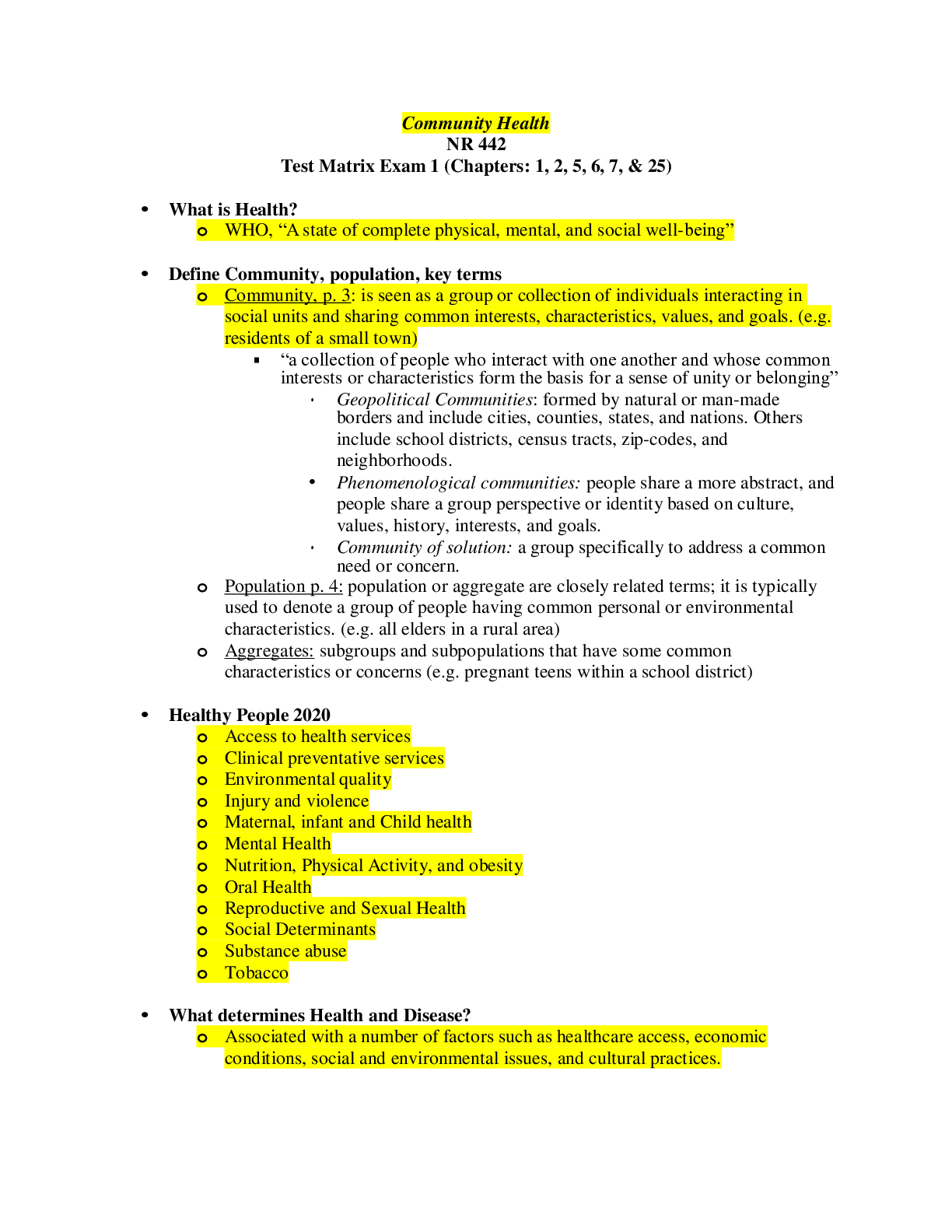
Reviews( 0 )
Document information
Connected school, study & course
About the document
Uploaded On
Oct 06, 2021
Number of pages
16
Written in
Additional information
This document has been written for:
Uploaded
Oct 06, 2021
Downloads
0
Views
28



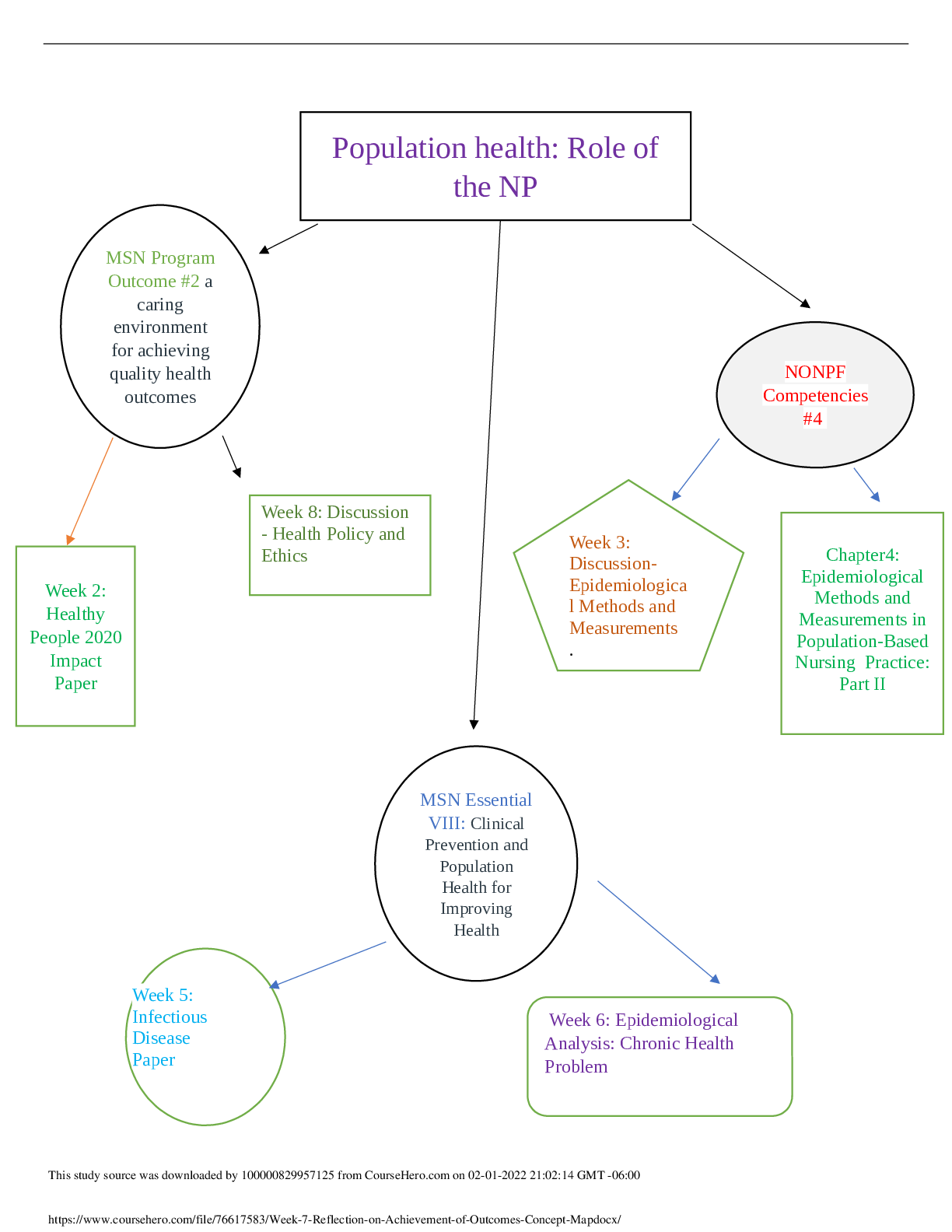


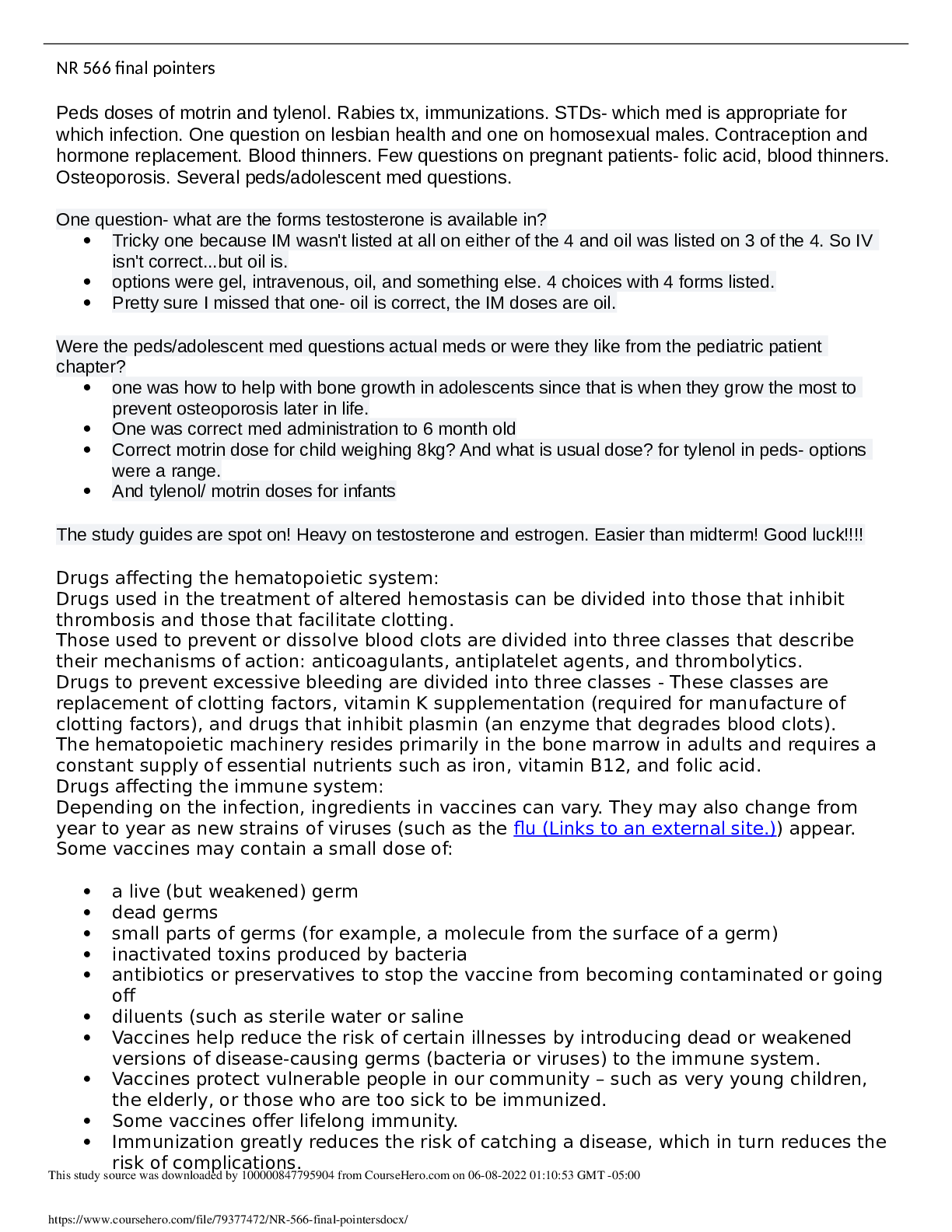

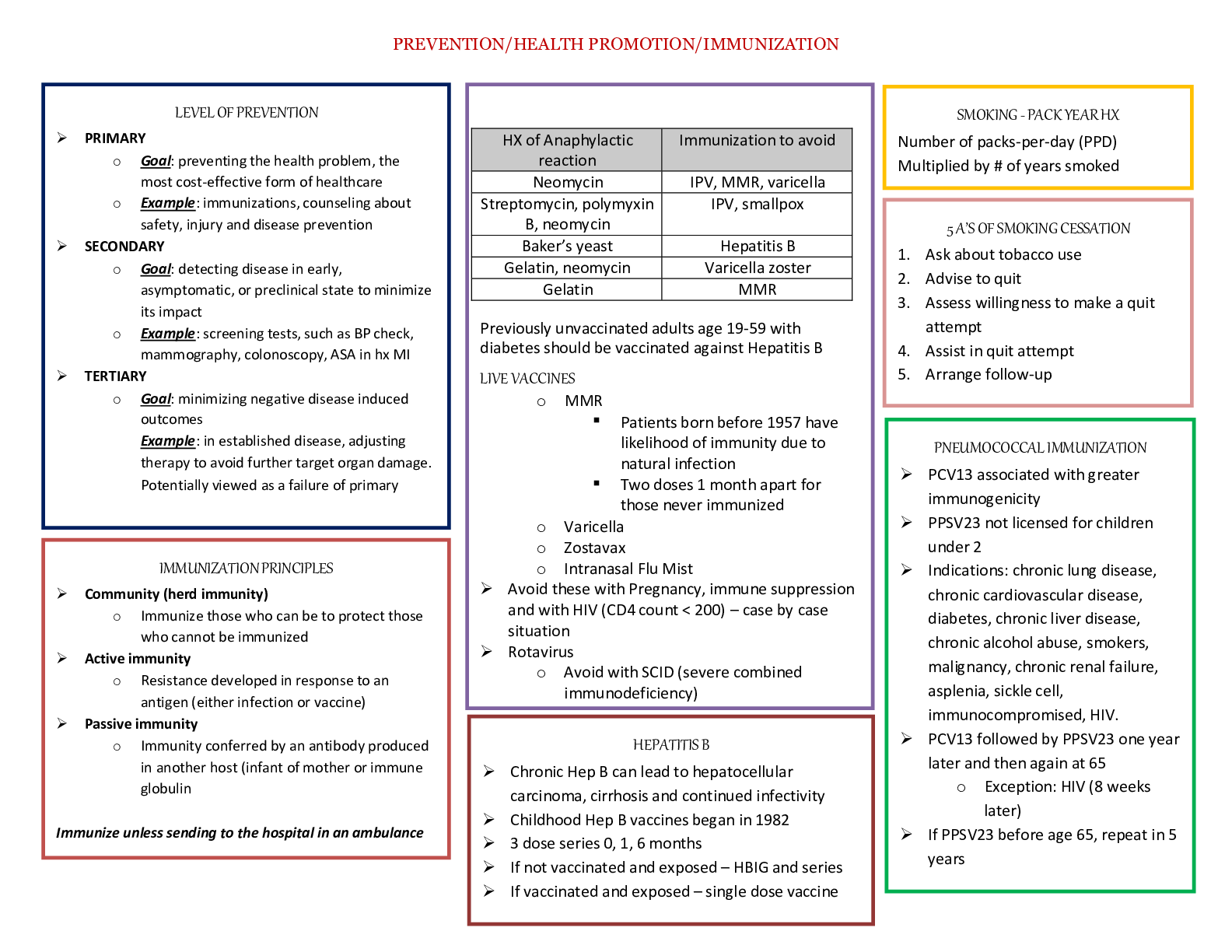
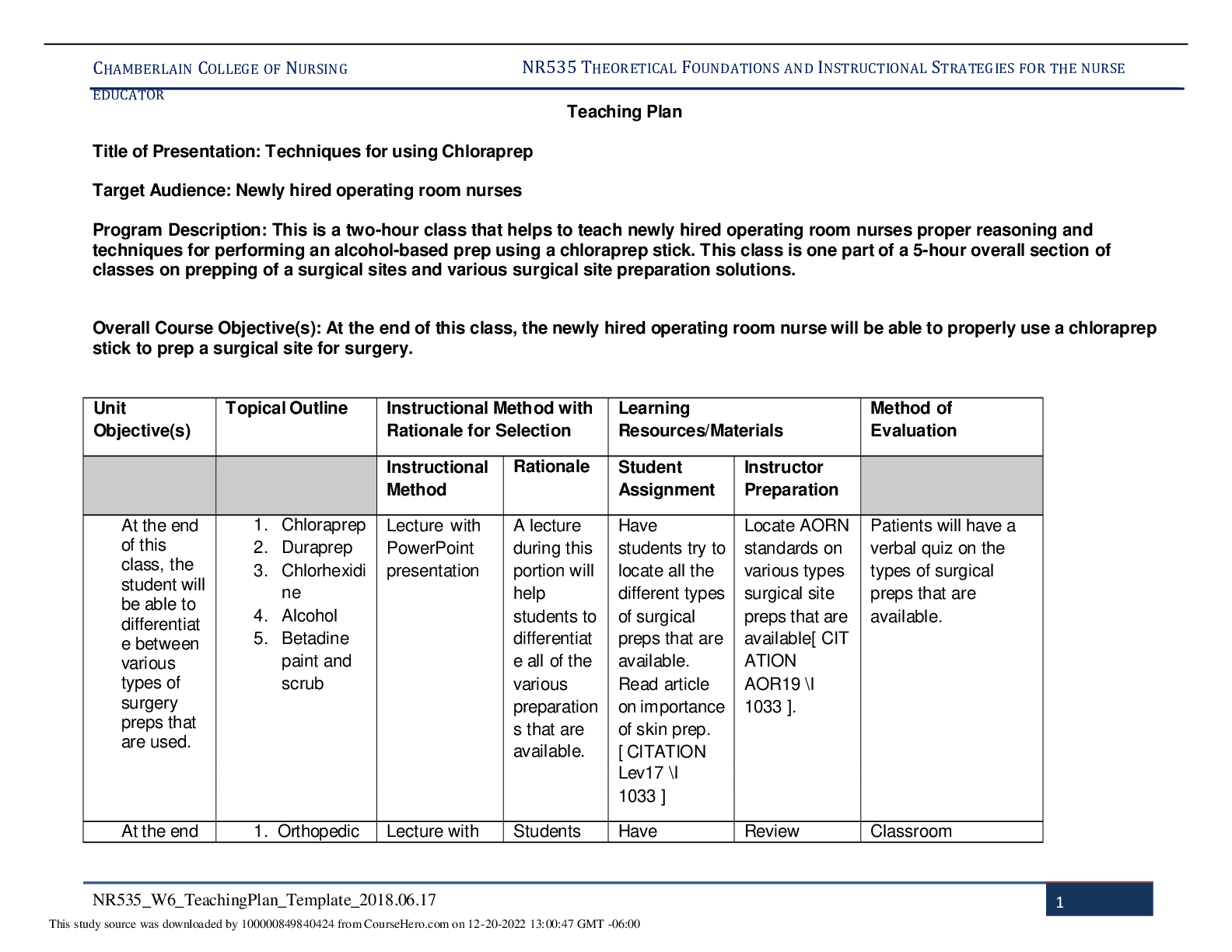

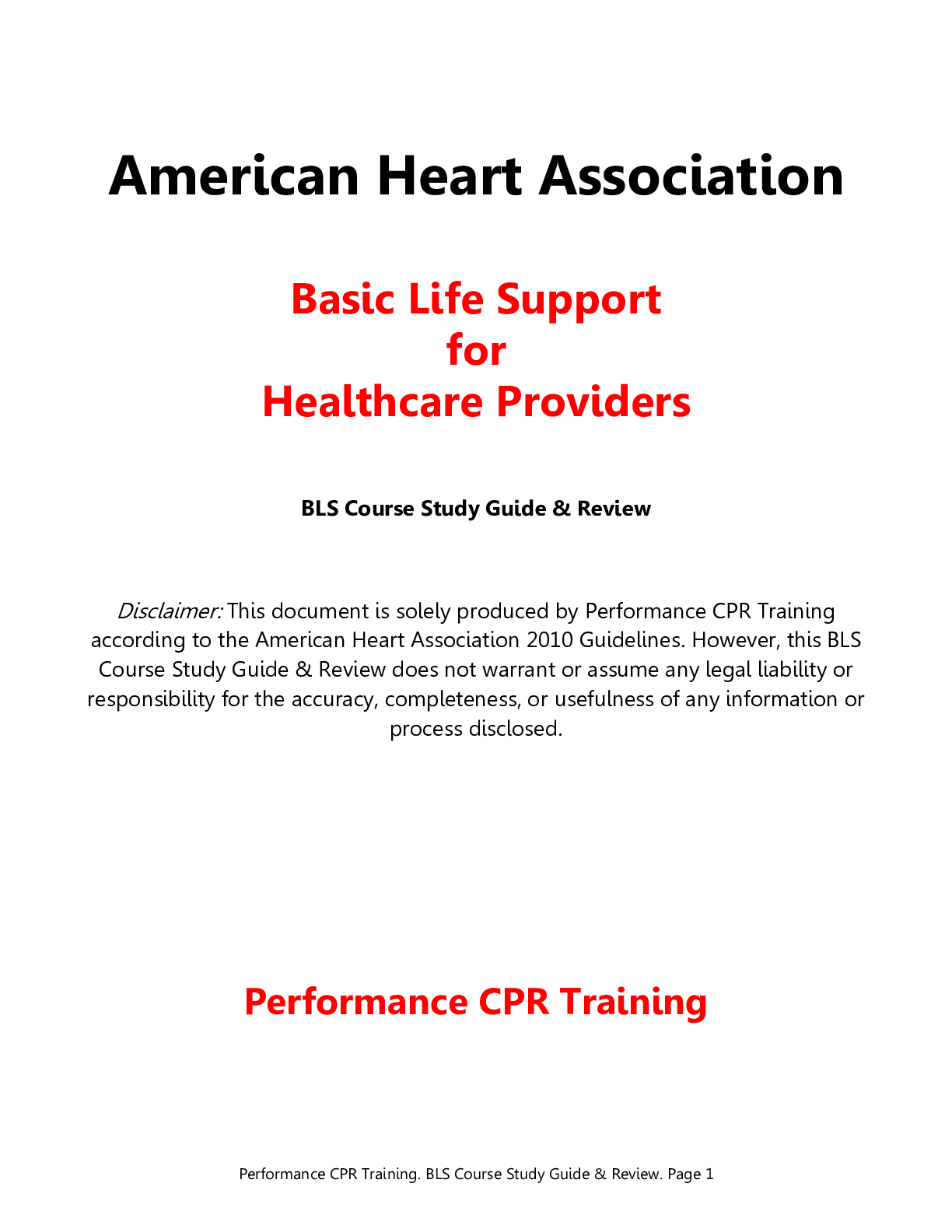
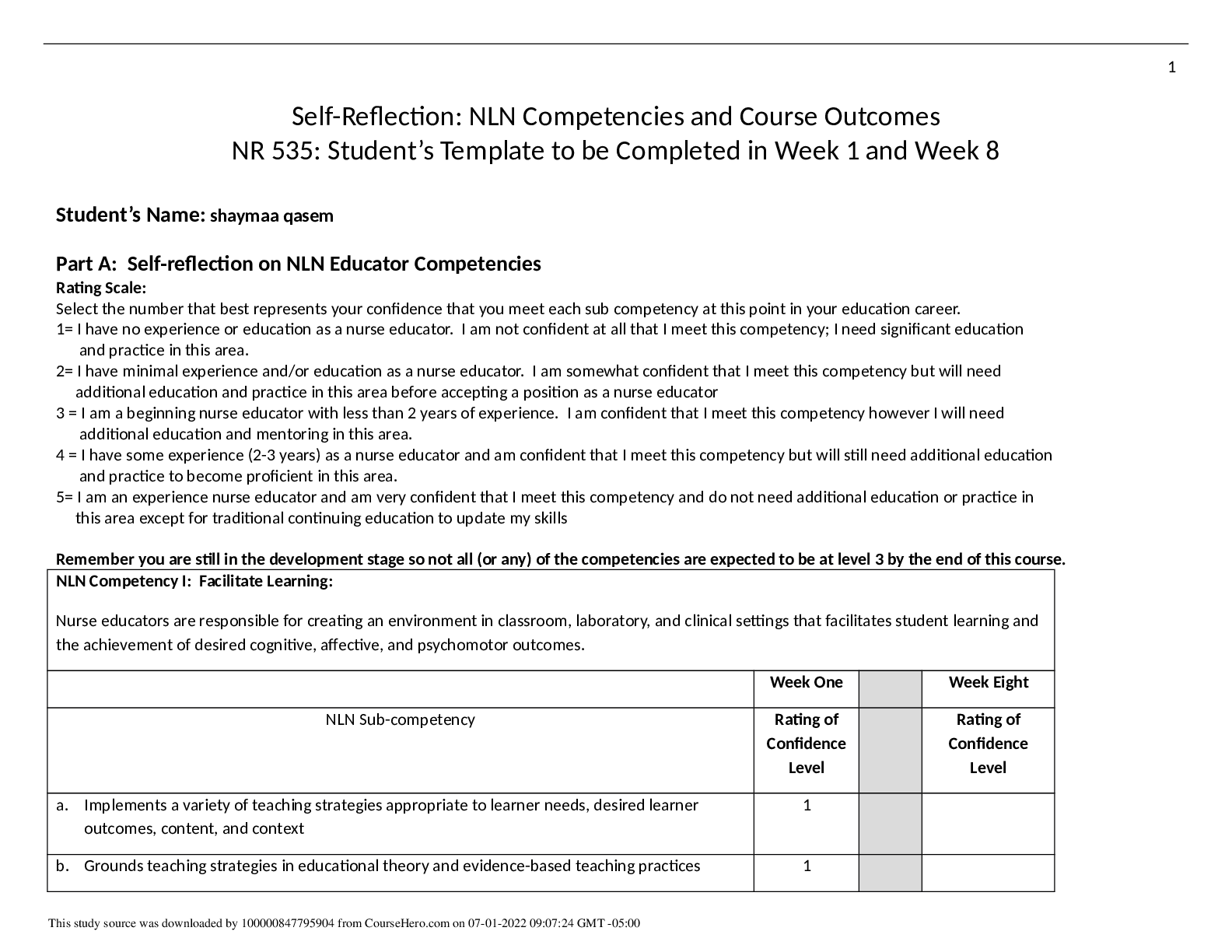

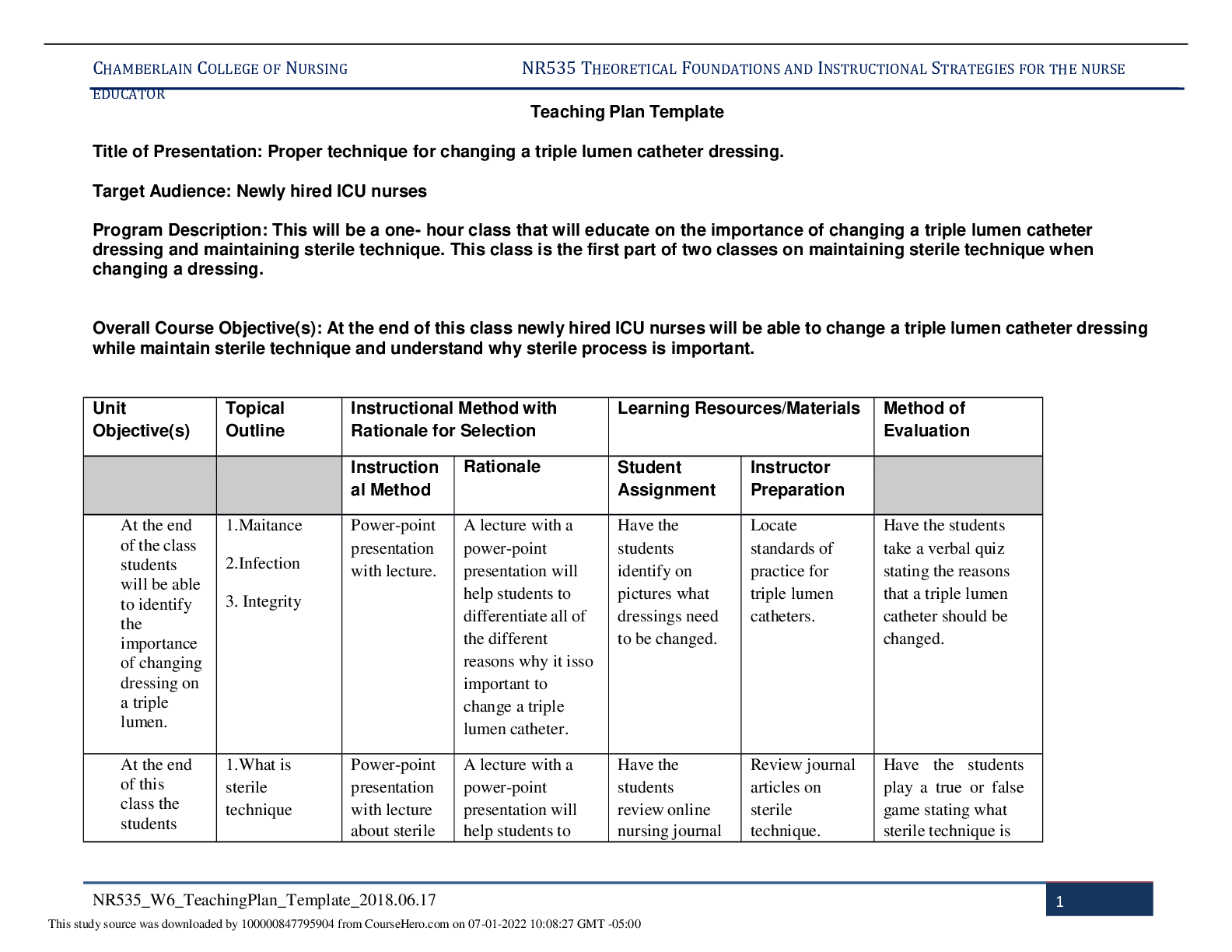
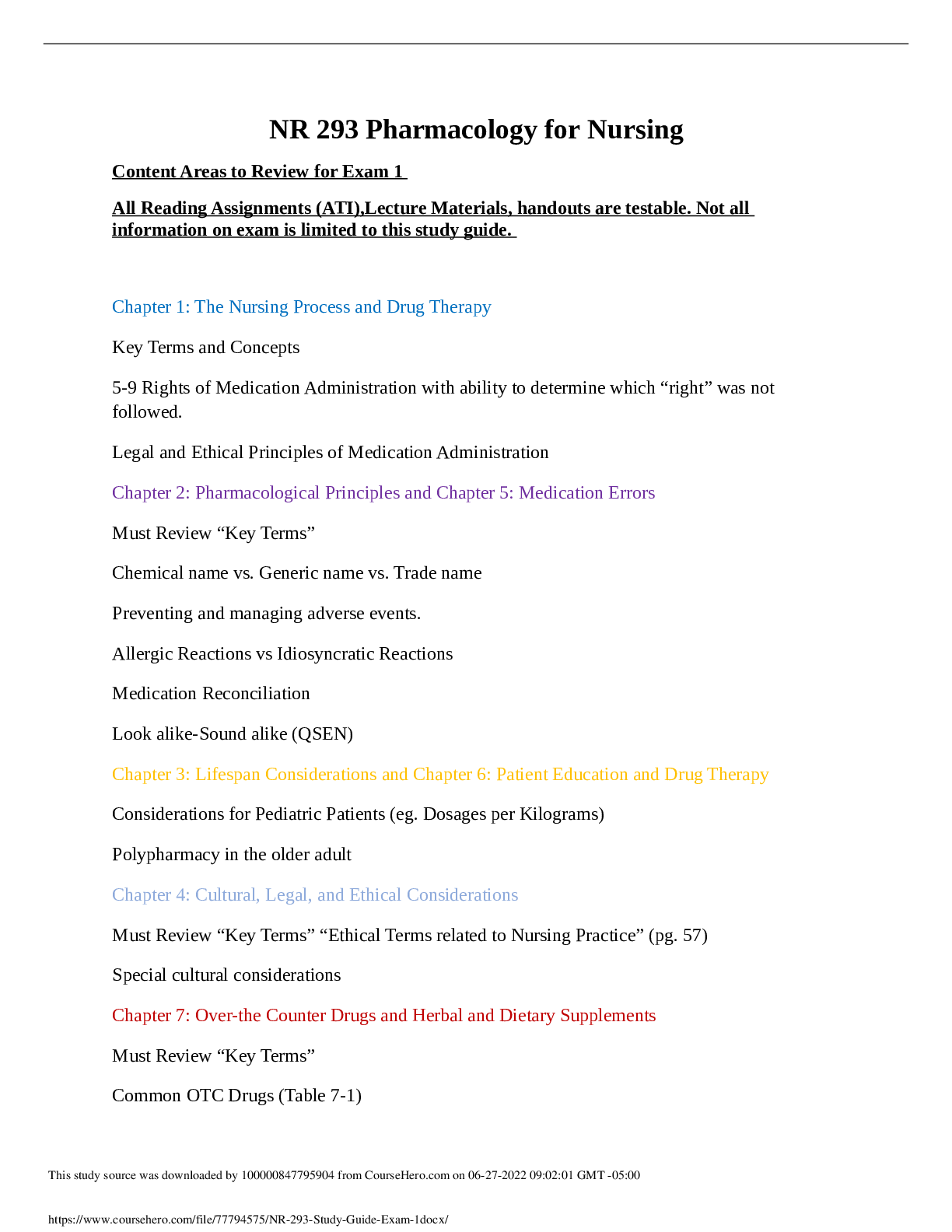

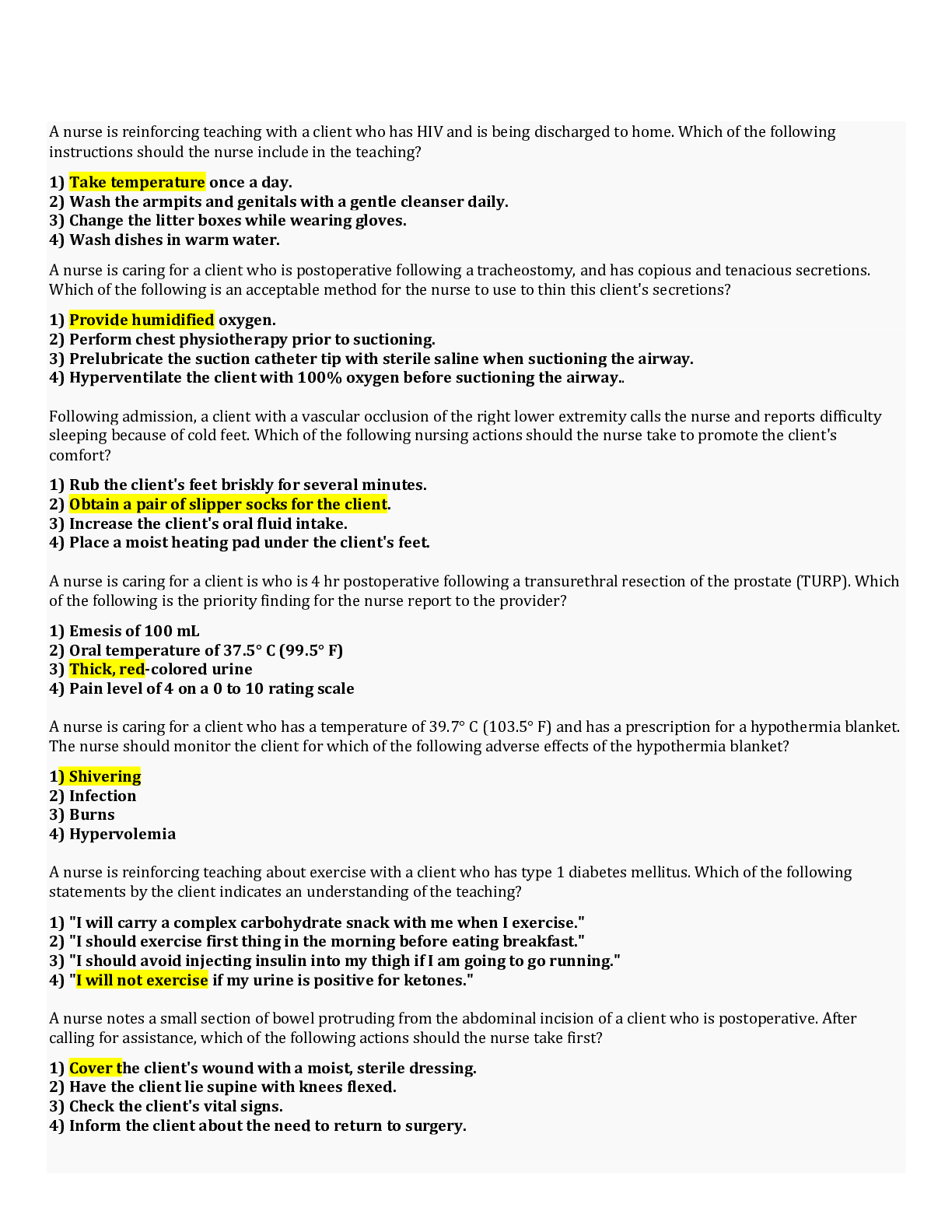
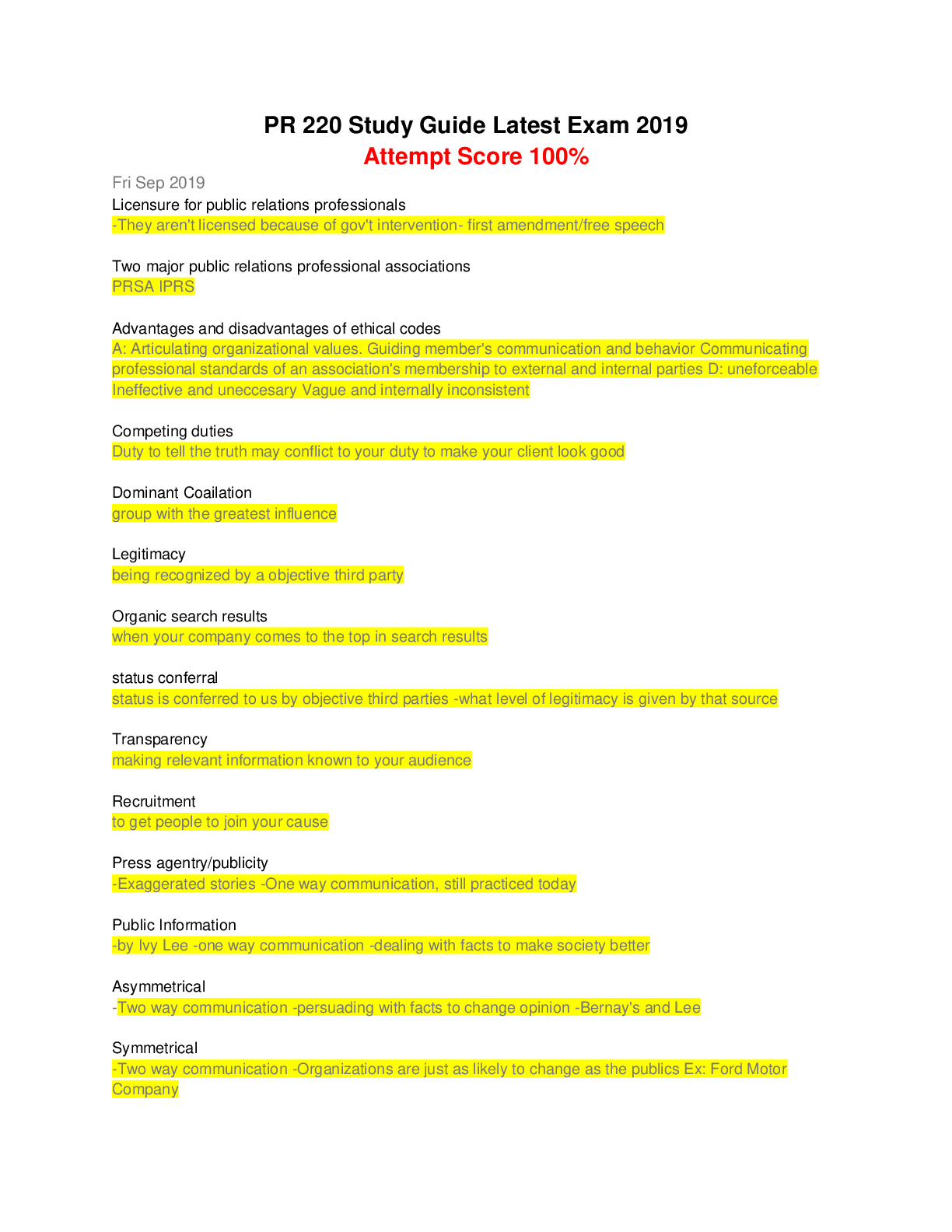

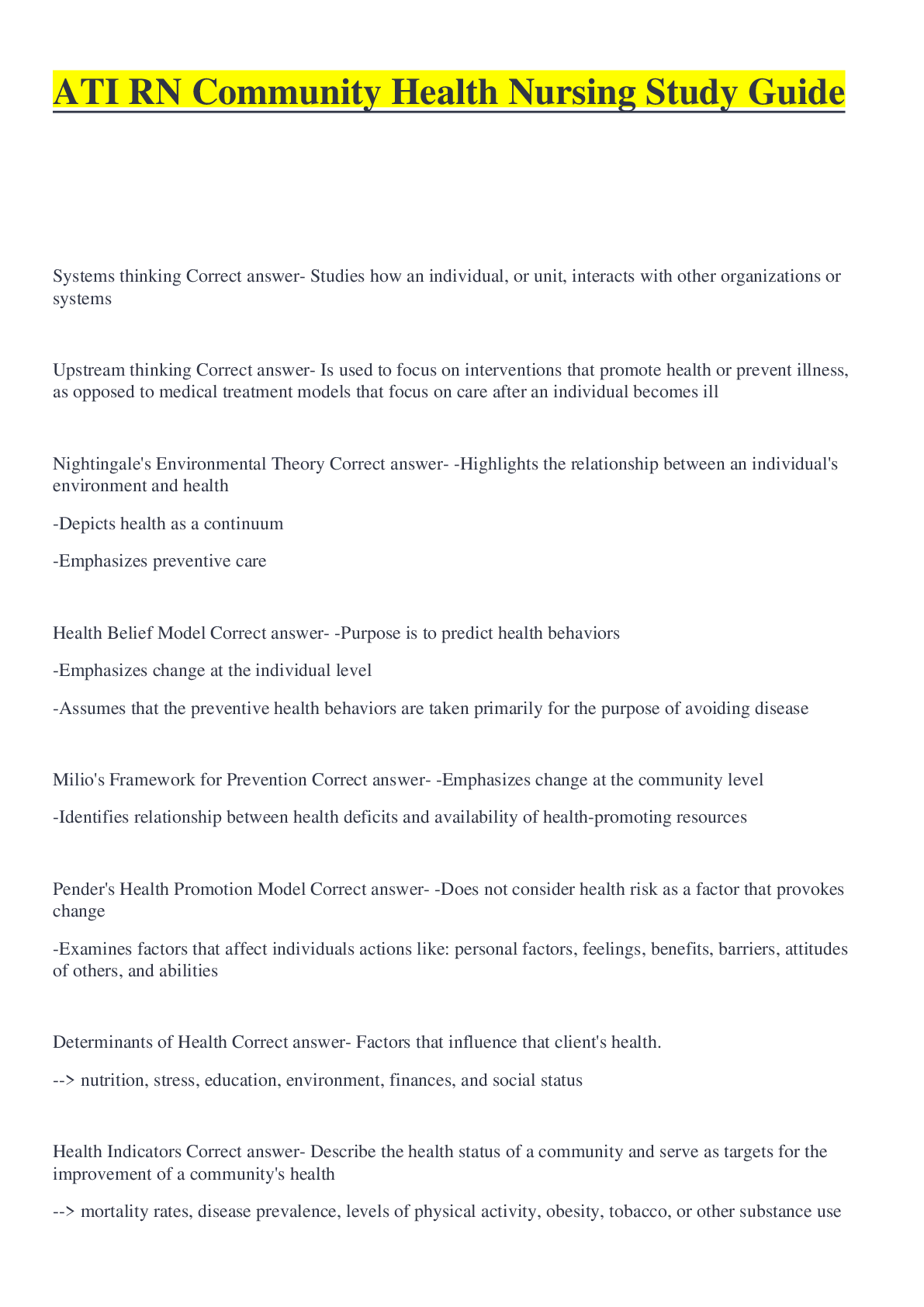
.png)
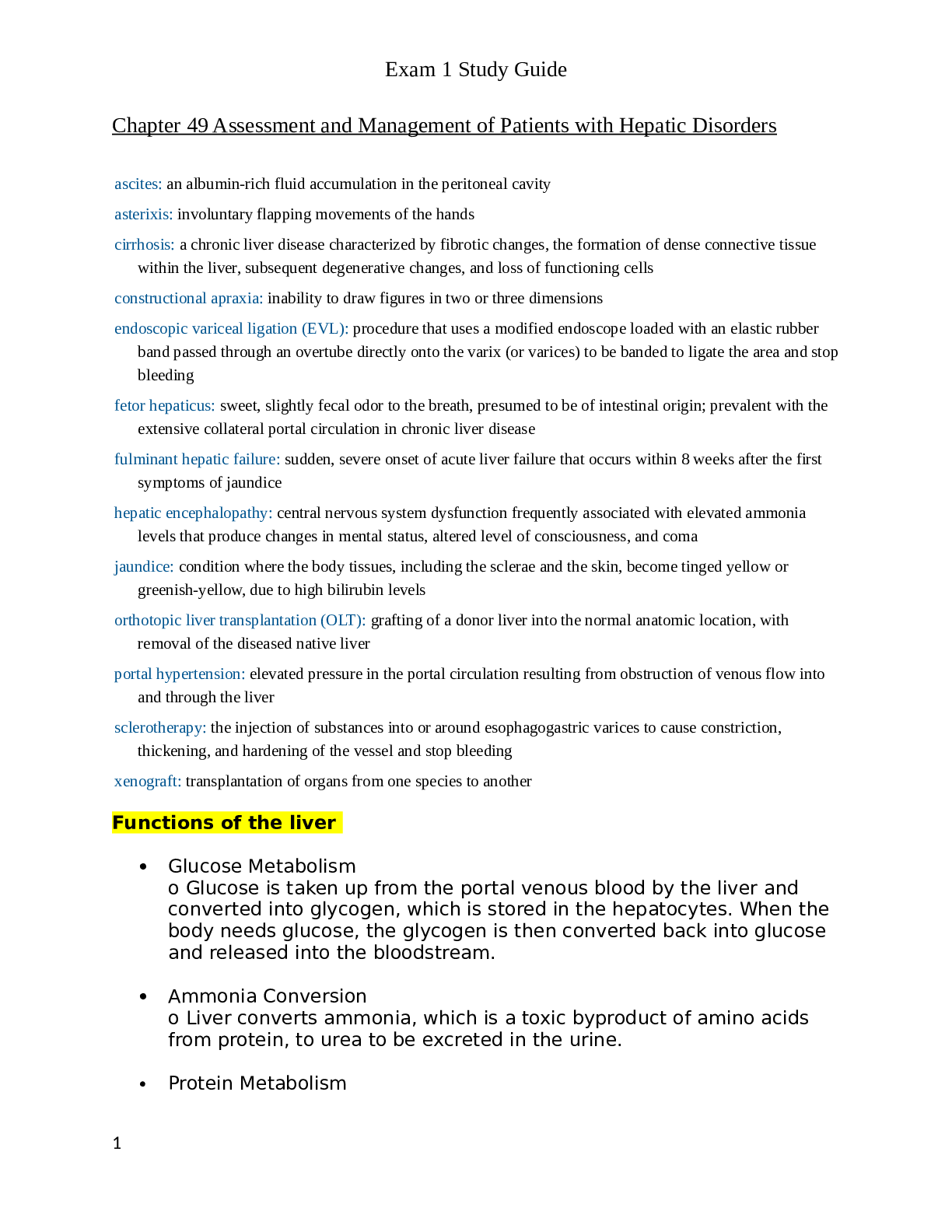

 (1).png)
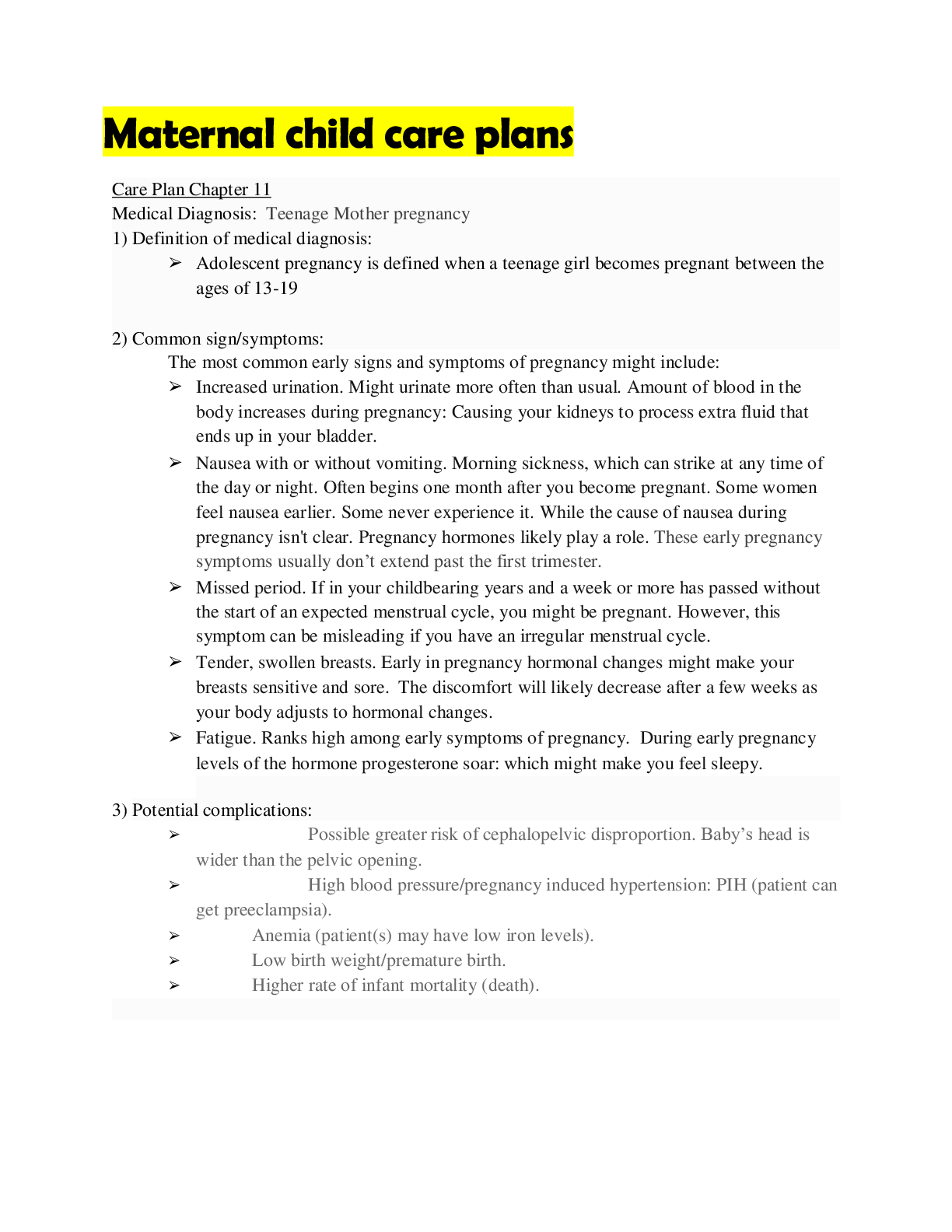


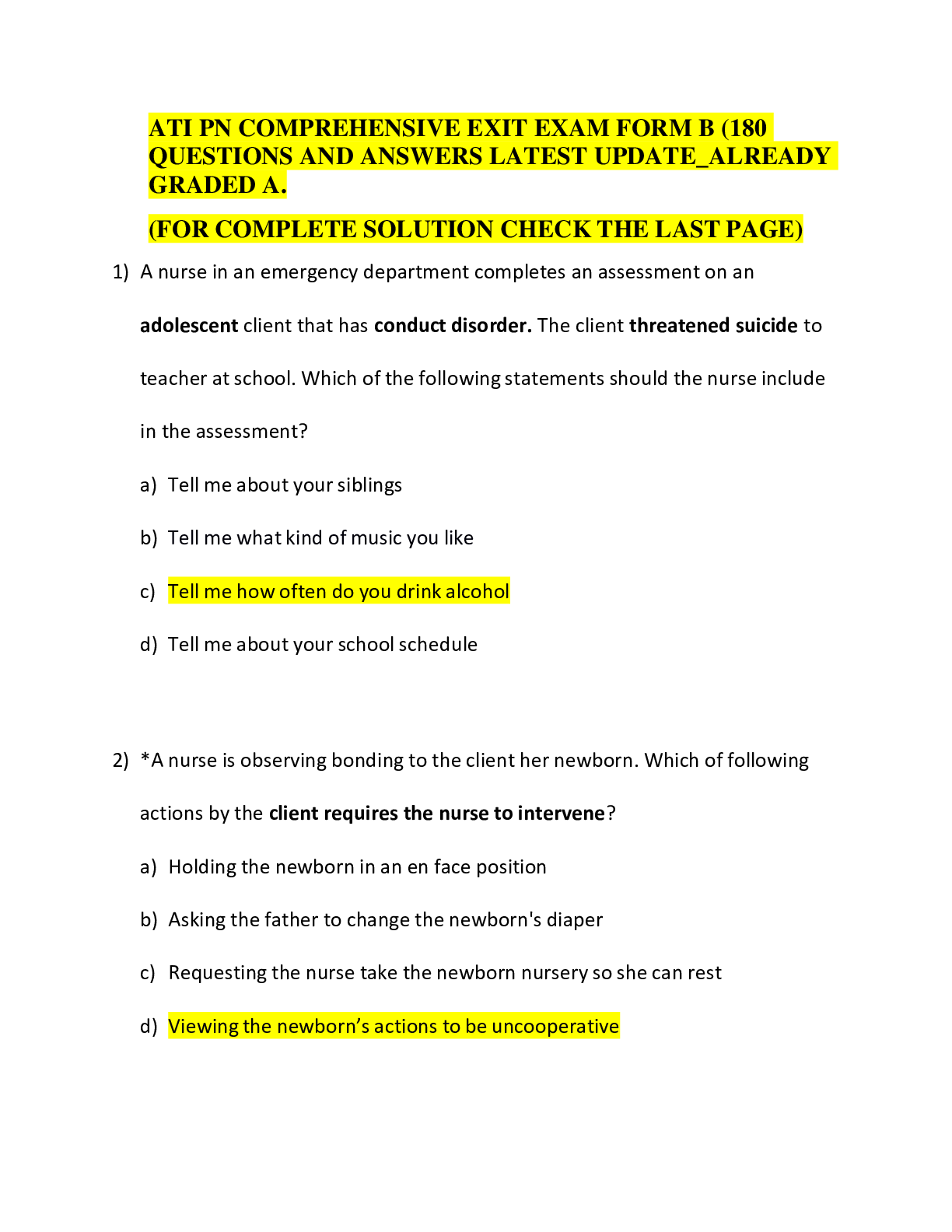
.png)
